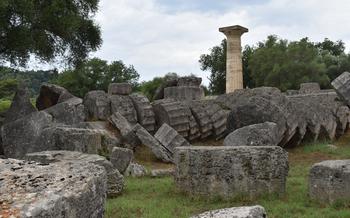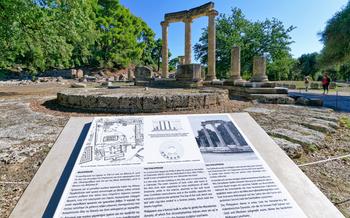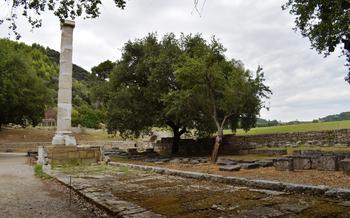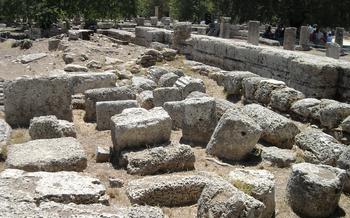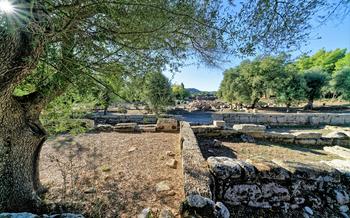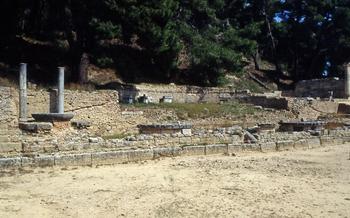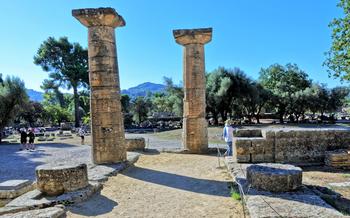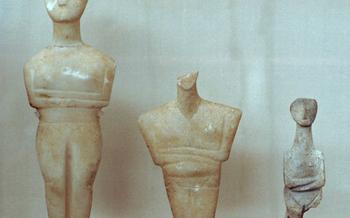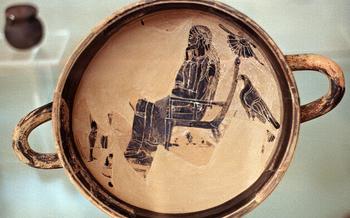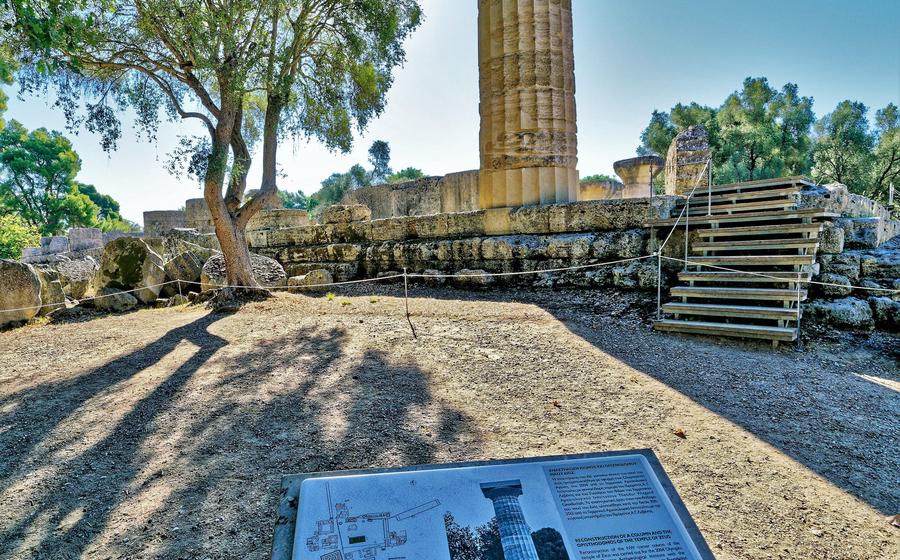
Selinounta Gorge
- Olympia: A Historical and Cultural Treasure
- Selinounta Gorge: A Natural Wonder
- Exploring the Gorge: A Hiking Adventure
- The Elati Forest: A Tranquil Retreat
- The Kladeos River: A Refreshing Dip
- Ancient Olympia: A Journey Through History
- The Archaeological Museum of Olympia: A Journey Through History
- The Temple of Zeus: A Masterpiece of Architecture
- The Olympic Stadium: Where Legends Were Made
- The Museum of the History of the Olympic Games
- The Olympic Flame Lighting Ceremony: A Symbolic Tradition
- The Olympic Torch Relay: A Symbol of Unity and Peace
- The Ancient Olympic Games: A Celebration of Sport and Culture
- Practical Tips for Visiting Olympia and the Selinounta Gorge
- Insider Tip: Hidden Gems of the Selinounta Gorge
Olympia: A Historical and Cultural Treasure
Olympia, nestled in the picturesque Peloponnese region of Greece, holds a prominent place in history and culture. As the birthplace of the Olympic Games, Olympia served as a sacred sanctuary dedicated to the worship of Zeus, the king of the gods in Greek mythology. The ancient Olympic Games, originating in 776 BC, were not merely sporting events but grand religious and cultural festivals that brought together athletes, artists, and spectators from all corners of the Hellenic world.
Olympia's rich cultural heritage is showcased through its impressive collection of ancient ruins, temples, and archaeological sites. The archaeological site of Olympia, a UNESCO World Heritage Site, offers a glimpse into the grandeur of this ancient sanctuary. Visitors can marvel at the remains of the Temple of Zeus, one of the Seven Wonders of the Ancient World, and the Olympic Stadium, where legendary athletes competed for glory and honor. The Archaeological Museum of Olympia houses a treasure trove of artifacts, including sculptures, pottery, and bronze statues that provide insights into the everyday life and rituals of ancient Greece.
Selinounta Gorge: A Natural Wonder
Just a short drive from the historical site of Olympia lies the Selinounta Gorge, a breathtaking natural wonder that offers a unique blend of stunning landscapes, rich biodiversity, and geological marvels. The gorge is easily accessible from Olympia, making it a perfect day trip or a starting point for a longer exploration of the region.
Formed over millions of years by the relentless erosion of the Selinountas River, the gorge boasts an impressive array of geological formations, including towering cliffs, deep ravines, and intriguing rock formations. The sheer walls of the gorge, adorned with diverse plant life, provide a vibrant contrast to the rugged terrain.
The gorge is home to a diverse array of flora and fauna. Lush vegetation, including aromatic herbs, wildflowers, and towering trees, carpets the gorge floor and clings to the rocky slopes. The air is alive with the songs of birds, and visitors may catch a glimpse of shy wildlife, such as rabbits, foxes, and even the occasional eagle soaring overhead.
Exploring the Gorge: A Hiking Adventure
The Selinounta Gorge offers a range of hiking trails that cater to diverse skill levels and preferences. Whether you're a seasoned hiker seeking a challenging trek or a nature enthusiast looking for a leisurely stroll, you'll find a trail that suits your needs.
For those seeking a moderate challenge, the trail along the gorge's rim provides breathtaking panoramic vistas and stunning views of the surrounding landscape. As you traverse the well-maintained paths, you'll encounter diverse flora and fauna, including wildflowers, aromatic herbs, and soaring birds of prey.
If you prefer a more strenuous hike, venture into the gorge's depths, where you'll encounter rugged terrain, cascading waterfalls, and hidden pools. The challenging trails here require sure footing and a sense of adventure, but the rewards are immense. The secluded swimming spots and pristine waterfalls offer a refreshing respite from the hike and a chance to soak in the tranquility of the gorge.
For those seeking a leisurely walk, the Elati Forest, adjacent to the gorge, offers a sanctuary of tranquility and shade. The gentle slopes and well-marked trails make it an ideal destination for families and nature lovers of all ages. As you wander beneath the towering pines, you'll be enveloped in the forest's serene atmosphere, punctuated by the melodious songs of birds and the gentle rustling of leaves.
The Elati Forest: A Tranquil Retreat
Just a short distance from the Selinounta Gorge lies the Elati Forest, a verdant oasis that invites you to escape into its serene embrace. Immerse yourself in the tranquility of this dense pine forest, where towering trees cast long shadows and the air is filled with the gentle rustling of leaves. Explore the network of hiking trails that wind their way through the forest, leading you to hidden glades and secluded spots where you can reconnect with nature and find moments of peace.
As you wander through the Elati Forest, marvel at the diverse flora and fauna that call this place home. Spot colorful wildflowers blooming amidst the greenery, and keep an eye out for shy creatures scurrying through the undergrowth. Listen to the melodious songs of birds as they flit among the branches, creating a symphony of sound that fills the air.
Whether you're seeking a challenging hike or a leisurely stroll, the Elati Forest offers trails for all levels of hikers. Choose a path that suits your pace and abilities, and let the tranquility of the forest envelop you as you explore its hidden treasures.
The Kladeos River: A Refreshing Dip
Flowing through the heart of the Selinounta Gorge, the Kladeos River invites visitors to immerse themselves in its crystal-clear waters. The river's pristine beauty and refreshing coolness provide a welcome respite from the warm Greek sun and the challenging hikes through the gorge.
Several designated swimming spots along the river's banks offer safe and accessible areas for taking a dip. These spots are ideal for cooling off after a strenuous hike or simply relaxing and enjoying the tranquil surroundings. The crystal-clear waters allow for excellent visibility, making it a popular spot for snorkeling and observing the diverse aquatic life.
For those who prefer a more active experience, the Kladeos River offers opportunities for fishing. The river is home to a variety of fish species, including trout, bass, and carp, making it a popular destination for anglers. Whether you're a seasoned angler or a beginner looking to try your luck, the Kladeos River provides a scenic and rewarding fishing experience.
Ancient Olympia: A Journey Through History
Olympia holds a significant place in history as the birthplace of the Olympic Games, which were first held in 776 BC. Located within walking distance of the Selinounta Gorge, the archaeological site of Olympia offers a fascinating journey through ancient history and culture.
Notable landmarks include the Temple of Zeus, a grand Doric temple that once housed the colossal statue of Zeus, one of the Seven Wonders of the Ancient World. The Olympic Stadium, where the ancient Olympic Games were held, is another must-see attraction. Its well-preserved design showcases the starting line, finish line, and seating areas for spectators.
The Museum of Olympia houses an extensive collection of artifacts unearthed from the sanctuary, including ancient sculptures, pottery, and bronze statues. These artifacts provide valuable insights into the everyday life and culture of ancient Greece, particularly during the Olympic Games.
Exploring the ruins of Olympia is like stepping back in time, immersing yourself in the history and traditions of the ancient Olympic Games. It's a journey that combines natural beauty with cultural significance, making it a must-visit destination for anyone interested in history, sports, and ancient civilizations.
The Archaeological Museum of Olympia: A Journey Through History
In the heart of Olympia, nestled amidst the ruins of the ancient city, lies the Archaeological Museum of Olympia. This treasure trove of artifacts transports visitors back in time, offering a glimpse into the rich history and culture of ancient Greece. The museum's collection, spanning centuries of artistic and cultural achievements, is a testament to the enduring legacy of Olympia as a center of Hellenic civilization.
Among the museum's highlights are exquisite sculptures, intricate pottery, and stunning bronze statues, many of which were unearthed during excavations at the Olympic sanctuary. These artifacts provide invaluable insights into the artistic prowess of ancient Greek craftsmen and the religious beliefs and practices of the time. From the delicate features of marble statues to the intricate details of bronze figurines, each piece in the museum tells a story of a bygone era.
Particularly noteworthy is the collection of sculptures from the Temple of Zeus, including the iconic pediments depicting the mythical battle between the Centaurs and the Lapiths. These monumental works of art, with their expressive figures and dynamic compositions, showcase the mastery of ancient Greek sculptors.
The Archaeological Museum of Olympia is not merely a repository of artifacts; it is a gateway to understanding the everyday life and culture of ancient Greece. Through its collection, the museum brings to life the rituals and ceremonies, the athletic competitions, and the artistic expressions that defined this remarkable civilization.
The Temple of Zeus: A Masterpiece of Architecture
Amongst the ruins of ancient Olympia, the Temple of Zeus stands as a testament to the architectural prowess of the ancient Greeks. Constructed in the 5th century BC, this colossal Doric temple was dedicated to the king of the gods, Zeus, and served as the centerpiece of the Olympic sanctuary.
The temple's grandeur is evident in its sheer size, measuring approximately 64 meters in length, 27 meters in width, and 20 meters in height. Its massive columns, each standing over 10 meters tall, exude a sense of strength and solidity. The intricate carvings on the pediments, depicting scenes from Greek mythology, showcase the exceptional artistry of the time.
The most remarkable feature of the Temple of Zeus was the colossal statue of Zeus, crafted from ivory and gold by the renowned sculptor Phidias. Standing approximately 13 meters tall, this awe-inspiring statue was considered one of the Seven Wonders of the Ancient World. Though the statue itself has not survived, its majesty and grandeur continue to captivate visitors to this day.
The Temple of Zeus not only served as a place of worship but also played a significant role in the ancient Olympic Games. It was here that the Olympic flame was lit during the opening ceremonies, symbolizing the commencement of the Games. The temple also housed the treasury, where the offerings and donations made by athletes and spectators were stored.
Today, the ruins of the Temple of Zeus stand as a reminder of the splendor and glory of ancient Greece. Visitors can wander among the fallen columns, marveling at their size and the intricate details that adorn them. The temple's enduring legacy serves as a testament to the enduring power of Greek architecture and the timeless spirit of the Olympic Games.
The Olympic Stadium: Where Legends Were Made
In the heart of ancient Olympia, nestled amidst rolling hills and lush vegetation, lies the Olympic Stadium, an awe-inspiring testament to the birthplace of the Olympic Games. This ancient sporting arena, constructed in the 5th century BC, served as the epicenter of athletic competitions that transcended mere physical prowess and embodied the spirit of ancient Greece.
Step into the stadium, and you'll be transported back in time, surrounded by the echoes of legendary athletes who once graced this sacred ground. Imagine the thunderous roar of the crowd as they cheered on their favorites, the tension palpable in the air as competitors pushed their limits in pursuit of victory.
The stadium's design is a marvel of ancient engineering, showcasing the ingenuity and precision of the Greek architects. The elliptical track, measuring approximately 600 feet in length, was meticulously crafted to ensure fair and equal competition for all participants.
At the starting line, the athletes stood poised, their hearts pounding with anticipation. The sound of a trumpet signaled the commencement of the race, and they burst forth in a blur of motion, their feet pounding against the hardened earth.
The finish line, marked by a simple stone post, represented the culmination of intense effort and determination. As each athlete crossed the threshold, they were met with either the jubilation of victory or the bittersweet embrace of defeat.
But beyond the physical contests, the Olympic Stadium held a deeper significance. It was a place where rivalries were set aside, and the spirit of sportsmanship and camaraderie prevailed. The Games celebrated the human body and its capabilities, promoting the ideals of physical fitness, mental resilience, and fair play.
Today, the Olympic Stadium stands as a poignant reminder of the ancient Olympic tradition, its legacy forever intertwined with the spirit of competition and the pursuit of excellence.
The Museum of the History of the Olympic Games
In the heart of Olympia, nestled amidst ancient ruins and archaeological wonders, lies the Museum of the History of the Olympic Games. Dedicated to preserving and showcasing the rich legacy of the Olympic Games, this museum offers a captivating journey through the history and evolution of this global sporting event.
Step inside, and you'll be transported back in time as you explore immersive exhibits that tell the story of the ancient Olympic Games. Learn about their origins in Greek mythology, the significance of the Olympic truce, and the various sports and competitions that took place in ancient Greece.
Interactive displays and hands-on experiences bring the history of the Games to life. You can test your skills in ancient Greek sports, such as discus throwing and wrestling, and learn about the training methods and techniques used by ancient athletes.
The museum also sheds light on the modern Olympic Games, showcasing the evolution of the Games from their revival in the late 19th century to the present day. Explore exhibits on the different host cities, the changes in sports and competitions, and the growth of the Olympic movement.
Through its comprehensive collection of artifacts, interactive displays, and engaging storytelling, the Museum of the History of the Olympic Games offers a unique and unforgettable experience for visitors of all ages. It's a must-visit for anyone interested in sports history, the Olympic Games, or the rich cultural heritage of Greece.
The Olympic Flame Lighting Ceremony: A Symbolic Tradition
In ancient Greek mythology, the Olympic flame was believed to have been ignited by the sun god Apollo himself. This divine origin adds a layer of significance to the Olympic flame lighting ceremony, which holds a special place in the history of the Olympic Games.
The ceremony takes place at the Temple of Hera, where a High Priestess, dressed in traditional Greek attire, uses a parabolic mirror to concentrate the sun's rays and light the Olympic flame. This symbolic act represents the continuity of the Olympic tradition and the passing of the torch from one host city to the next.
The flame serves as a symbol of peace, unity, and the Olympic spirit. It travels from Olympia to the host city, carried by a relay of torchbearers, who are often renowned athletes or individuals who embody the Olympic ideals. The journey of the Olympic flame symbolizes the coming together of nations and the celebration of human achievement.
Whether witnessing the ceremony in person at Olympia or watching it broadcast worldwide, the Olympic flame lighting ceremony is a powerful and moving experience that captures the essence of the Olympic Games. It is a testament to the enduring legacy of ancient Greece and the values that continue to inspire athletes and fans around the world.
The Olympic Torch Relay: A Symbol of Unity and Peace
The Olympic torch relay is a cherished tradition that carries the Olympic flame from its birthplace in Olympia to the host city of the Olympic Games. This symbolic journey represents the unity and peace that the Olympic Games strive to promote worldwide.
The torch relay begins with a special ceremony in Olympia, where the High Priestess lights the Olympic flame using a parabolic mirror and the sun's rays. The flame is then carried by a series of torchbearers who run in relays, passing the torch from one to another. The torchbearers are chosen for their athletic achievements, their dedication to the Olympic ideals, and their inspiring stories.
As the torch makes its way to the host city, it passes through various countries and communities, spreading the message of friendship, cooperation, and sportsmanship. The torch relay provides an opportunity for people worldwide to come together and celebrate the spirit of the Olympic Games.
The final leg of the torch relay is particularly significant, as the last torchbearer carries the flame into the Olympic Stadium during the opening ceremony. The lighting of the Olympic cauldron marks the official start of the Olympic Games, symbolizing the unity of athletes from all nations competing in the spirit of sportsmanship and excellence.
The Ancient Olympic Games: A Celebration of Sport and Culture
The ancient Olympic Games, held in Olympia every four years, were not merely sporting events but grand celebrations of athleticism, culture, and religious devotion. Their origins are shrouded in myth and legend, with some attributing their inception to the legendary hero Hercules, while others trace their roots back to the worship of Zeus, the king of the gods.
Initially, the Games were exclusively religious in nature, with competitions held in honor of Zeus and other deities. Over time, they evolved into multifaceted events that showcased not only physical prowess but also artistic and intellectual achievements. The Games included a wide range of sports, including footraces, wrestling, boxing, chariot racing, and the pentathlon, a grueling test of strength and endurance comprising five events: running, jumping, discus and javelin throwing, and wrestling.
Beyond sports, the ancient Olympic Games played a significant cultural and social role. They provided a platform for artists, poets, and musicians to showcase their talents, and were a time of truce and unity among the often-warring Greek city-states. The Games also fostered a sense of pan-Hellenic identity, uniting the diverse Greek peoples under a shared cultural and religious heritage.
Practical Tips for Visiting Olympia and the Selinounta Gorge
To make the most of your trip to Olympia and the Selinounta Gorge, consider visiting during the shoulder seasons (spring and autumn) to avoid the summer crowds and enjoy milder temperatures. Pack comfortable hiking shoes, a refillable water bottle, and layers of clothing for the changing weather conditions. Accommodation options range from budget-friendly hostels and guesthouses to comfortable hotels and resorts in Olympia and the surrounding towns. Book your stay in advance, especially during the peak tourist season. Remember to bring your camera to capture the stunning scenery and wildlife encounters.
Insider Tip: Hidden Gems of the Selinounta Gorge
For an unforgettable experience, venture off the beaten path and explore the hidden gems of the Selinounta Gorge. Discover secluded swimming spots amidst lush vegetation, where you can immerse yourself in the crystal-clear waters and soak up the tranquility of the natural surroundings. Indulge in the authentic flavors of Greece at local tavernas nestled within the gorge, savoring delicious traditional dishes prepared with fresh, local ingredients. With a keen eye, you might encounter wildlife unique to the region, providing ample opportunities for wildlife photography and birdwatching. Embrace the chance to create lasting memories in this enchanting natural paradise.
